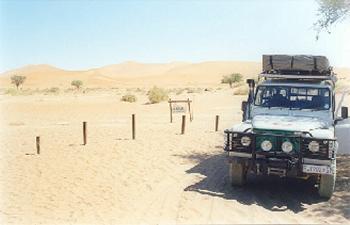It could be well worth your while to print out this article, laminate it and keep it in a safe place in your 4x4, should the need ever arise.
Before venturing into any desert area, there are basic precautions that you should adhere to:
That you are familiar with 4x4 sand driving and with the procedure to recover a stuck vehicle.
That you have a compass or GPS as well as a map of the area that you will be travelling through.
Somebody at home knows your travel route, destination and timeframe of the journey.
Your 4x4 is well maintained, especially the tires, coolant and electrical system.
You carry a vehicle toolkit, including jumper cables, towrope, "tyre weld" aerosols, tyre compressor and fire extinguisher.
The vehicle should have a spare fan belt, spark plugs, hose clamps and extra oil and coolant. Always throw in a roll of heavy-duty duct tape.
Your vehicle has a comprehensive first-aid kit, hi-lift jack, spade and spare wheel
A basic Leatherman/utility tool, signal mirror, matches and pocket flashlight is always stowed in the vehicle.
Enough water for all passengers is on-board. At least four to 5 litres per person per day.
Water purification tablets or Iodine pills.
DO NOT depend on having cell phone coverage if you are stuck.
There are inherently three critical threats when stuck in a desert: Hypothermia, Hyperthermia and Dehydration. Translated, this really means regulating your body temperature and consuming enough water at all times. A breakdown or a recovery situation still occurs to the best of us and when it does, some basic techniques will greatly enhance your chances of survival.
Never ration your water. There exists documented cases where people have died of dehydration with water still in their water bottles. Dehydration, with extreme fatigue as an early symptom, also affects your judgement in extreme situations.
Do not hike or do physical activities in the middle of the day. Use this time to conserve energy and prepare distress signals.
Find shade or shelter and if not available, erect a tarp, a blanket or even use the car's seats to make shade.
If need be, breath through your nose, which reduces moisture loss.
Do not consume salt, drink alcohol, smoke or even talk excessively, as this all leads to additional water loss or dehydration.
Do not concern yourself with eating or finding food. Most people can easily go without food for two or three weeks. Consuming any only speeds up the body's metabolic rate and therefore requires even more precious water. The maximum time without water is about 72 hrs in a desert.
Do not leave the vehicle unless you have a clear objective and can travel when it is cooler! It is relatively easy to spot a vehicle over a great distance, even from the air, as opposed to a human being. In addition to that, most of your emergency supplies are in the car. Raise the vehicle's bonnet to indicate an emergency.
If you find a road, stay on it. A road is always a sign of civilisation and chances are that you will meet up with other travellers!
Ensure that you head is covered from the sun at all times and wear sunglasses to protect your eyes. Do not sit or lie on the ground, as it may be 20-35 degrees warmer than the ambient air temperature! Keep your clothes on as this helps slow down evaporation of sweat and assists your body with cooling. Not to mention, preventing sunburn!
Make a clearly visible signal for potential emergency rescue teams! This could be in the form of a triangle laid out on the ground made from aluminium foil, newspapers or rocks. The letter "I" would indicate some one is injured, "X" would mean that you are unable to proceed and "F" indicates you need food and water.
Use a hand mirror to signal to overhead planes. You can salvage the rear-view mirror as an alternative.
Make a controlled fire! If you do not have matches use the cigarette lighter. The car battery can always be used by connecting both jumper cables to some steel wool or creating a spark and holding it against some dry tinder.
During daytime, a fire with lots of smoke is a good idea. If need be, use parts of the vehicle, such as the spare tire, rubber floor mats, seats etc to generate more smoke. At night time, ensure that the fire is as bright as possible. By arranging three fires in a triangle, the international distress "help needed" signal is denoted.
Should your water supplies be running low, dig for water sources at the outside edge of a sharp bend in a dry riverbed, or at the base of rock cliffs. Should you discover wet sand, continue digging deeper until water starts seeping through.
Green vegetation, animals paths and flocks of birds are always a good indicator of the presence of water
At night, ensure that you are well protected from the elements, as most deserts can become freezing at night. The first signs of hypothermia include intense shivering, poor co-ordination, and blueness of the outer extremities, excessive talking, giggling and other non-normal behaviour.
As a final cautionary, be aware of flash floods in the desert. Do not any under circumstances, ever camp in a dry riverbed. Above all, when trying to survive in any extreme situation, keep your head and do not panic.
Until next time!
We live in a world where facts and fiction get blurred
Who we choose to trust can have a profound impact on our lives. Join thousands of devoted South Africans who look to News24 to bring them news they can trust every day. As we celebrate 25 years, become a News24 subscriber as we strive to keep you informed, inspired and empowered.





 Publications
Publications
 Partners
Partners














